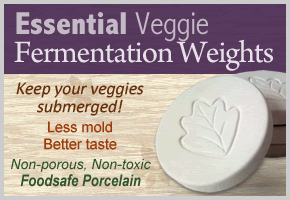http://vimeo.com/84174392
Fermented vegetables are considered safer for novices to make than canned vegetables.This is good news, as we all know that food safety is very important. To examine this further, let’s take a look at a quote from Fred Breidt, a USDA research service microbiologist, on the safety of fermented vegetables.
Lactic acid bacteria take over and kill any bad bacteria that maybe present! Having a batch go bad is possible, but very rare. We’ve been fermenting and teaching others how to ferment vegetables for years… and we’ve only had a couple of “bad” batches over all that time. So how do you tell if a batch may be bad?
3-Step Test – Is my ferment Bad?
If the food fails any of these tests or if you feel something is wrong with it. Then follow our motto: If in doubt, throw it out! (Hey it’s only a few dollars worth of vegetables.) Storage of Fermented FoodsAs we talked about earlier in history, our ancestors used root cellars or buried the foods to keep them cool, below 50 degrees. We will be using the refrigerator, near 40 degrees or less. The lacto-fermentation process still keeps going while in a cooled state, it is just slowed down. Keeping the foods cold allows for maximum longevity.
Generally the harder the raw vegetable, the longer it takes to process, and the longer it stores. Pickles take only a few days to lacto-ferment and store much less time than cabbage which takes over a week to process and lasts many months. Fermented foods keep maturing or ripening overtime so they tend to just get a slight over ripe taste to them as they go bad. The probiotic bacteria has just over grown the food and now it is past the palatability of what you like. Sort of like an over ripe banana. It does not taste good, but is not harmful. Mom sure can make some yummy banana bread out of those overripe bananas! We joked about the mason jar convention in an earlier video lesson, but this is how our refrigerator looks. The fermenting kits we sell fit all sizes of wide-mouth mason jars, so as soon as a ferment is done it is capped with a storage lid and put in the refrigerator for storage. Continue to Lesson 6 – Homemade Yogurt —>
|
|
...obtaining better health with God foods
Disclaimer
The nutritional advice provided through this website is intended to educate individuals about diet and a healthy lifestyle approach. No advice provided is intended to diagnose, cure, or prevent any disease; or be construed as a substitute for medical attention. Individuals with a specific medical condition or concern should seek advice from a physician.
Copyright © 2016 Cooking God's Way · License & Usage · Disclaimer & Privacy Notice · Shipping & Refunds · Affiliate Program





